cooling Oldsmobile Aurora 1998 s User Guide
[x] Cancel search | Manufacturer: OLDSMOBILE, Model Year: 1998, Model line: Aurora, Model: Oldsmobile Aurora 1998Pages: 380, PDF Size: 19.75 MB
Page 237 of 380

I NOTICE:
In cold weather, water can freeze and crack the
engine, radiator, heater core and other parts.
So
use the recommended coolant.
I A CAUTION:
You can be burned if you spill coolant on hot
engine parts. Coolant contains ethylene glycol
and it will burn if the engine parts are hot
enough. Don’t spill coolant on
a hot engine.
1. You can remove the coolant surge tank pressure cap
when the cooling system, including the coolant surge
tank pressure cap and upper radiator hose, is no
longer hot. Turn the pressure cap slowly about
one-quarter turn to the left and then stop.
If you hear a hiss, wait for that to stop. A hiss means
there is still some pressure
left.
5-21
Page 239 of 380

4. With the coolant surge tank pressure cap off, start the
engine and let
it run until you can feel the upper
radiator hose getting hot. Watch out for the engine
cooling fans.
5. Then replace the pressure cap. Be sure the pressure
cap is tight.
By this time, the coolant level inside the coolant
surge tank may be lower.
If the level is lower, add
more of the proper mixture to the coolant surge tank
until the level reaches
FULL COLD.
5-23
Page 273 of 380
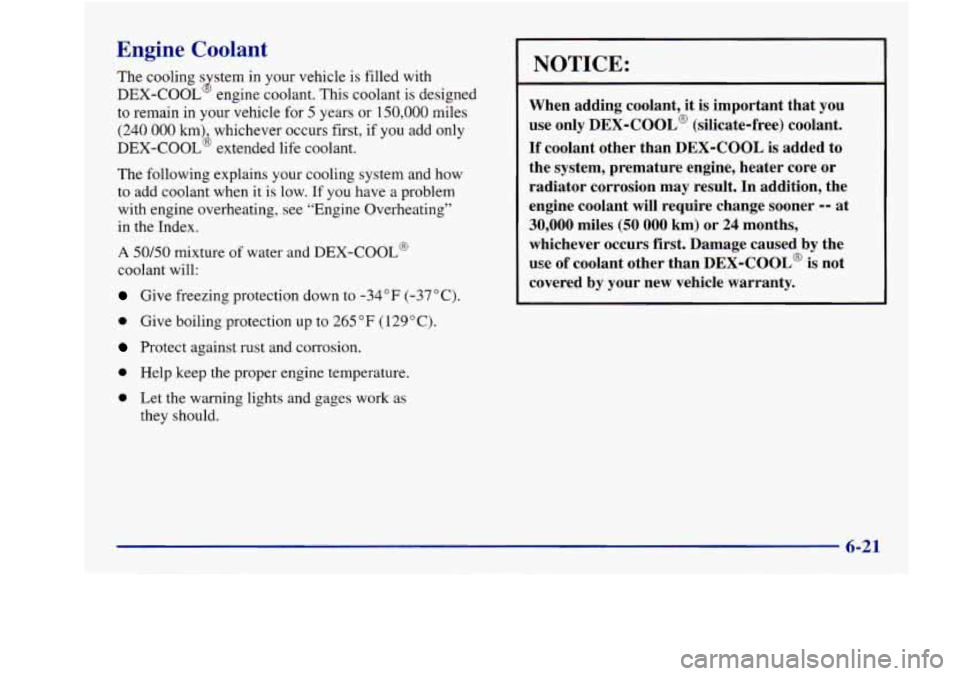
Engine Coolant
The cooling s stem in your vehicle is filled with
DEX-COOL engine coolant. This coolant is designed
to remain in your vehicle for
5 years or 150,000 miles
(240 000 km) whichever occurs first, if you add only
DEX-COOL’ extended life coolant.
J
The following explains your cooling system and how
to add coolant when it is low. If you have a problem
with engine overheating, see “Engine Overheating”
in the Index.
A 50/50 mixture of water and DEX-COOL@
coolant will:
Give freezing protection down to -34°F (-37°C).
0 Give boiling protection up to 265 “F (129 “C).
Protect against rust and corrosion.
0 Help keep the proper engine temperature.
0 Let the warning lights and gages work as
they should.
NOTICE:
When adding coolant, it is important that you
use only
DEX-COOL@ (silicate-free) coolant.
If coolant other than DEX-COOL is added to
the system, premature engine, heater core or
radiator corrosion may result. In addition, the
engine coolant will require change sooner
-- at
30,000 miles (50 000 km) or 24 months,
whichever occurs
first. Damage caused by the
use
of coolant other than DEX-COOL@ is not
covered by your new vehicle warranty.
Page 274 of 380

What to Use
Use a mixture of one-half clean water (preferably
distilled) and one-half
DEX-COOL@ coolant which
won’t
damage aluminum parts. If you use this mixture,
you don’t need to add anything else.
Adding only plain water to your cooling system
can be dangerous. Plain water, or some other
liquid like alcohol, can boil before the proper
coolant mixture will. Your vehicle’s coolant
warning system is set for the proper coolant
mixture. With plain water or the wrong mixture,
your engine could get too hot but you wouldn’t
get the overheat warning. Your engine could
catch fire and you or others could be burned.
Use
a 50/50 mixture of clean water and
DEX-COOL@ coolant.
NOTICE:
If you use an improper coolant mixture, your
engine could overheat and be badly damaged.
The repair cost wouldn’t be covered by your
warranty.
Too much water in the mixture can
freeze and crack the engine, radiator, heater core
and other parts.
If you have to add coolant more than four times a year,
have
your retailer check your cooling system.
NOTICE:
~~ ~
If you use the proper coolant, you don’t have to
add extra inhibitors or additives which claim to
improve the system. These can be harmful.
6-22
Page 302 of 380
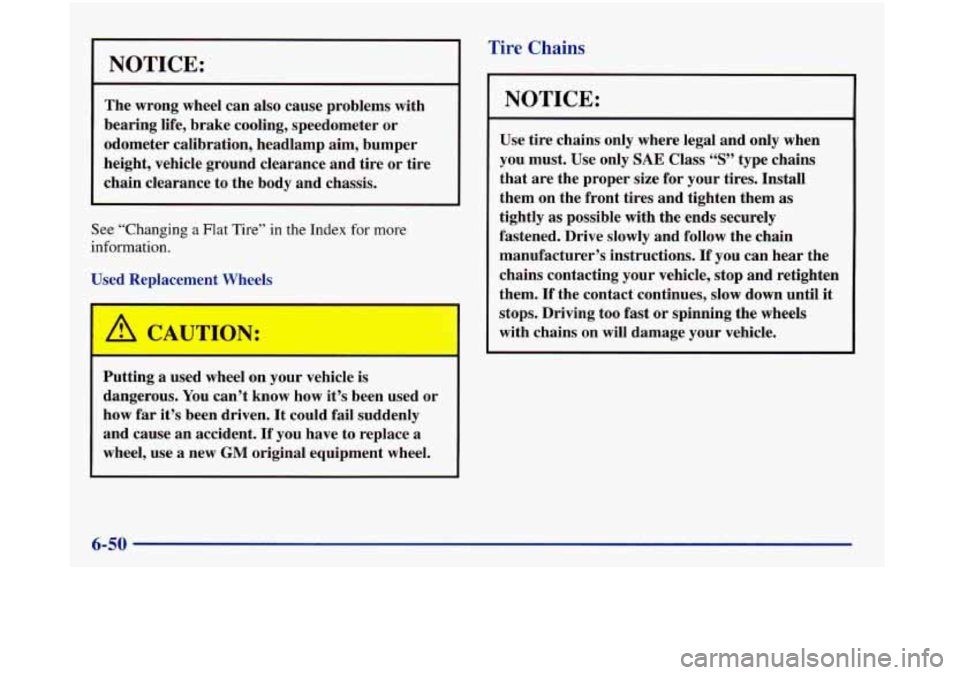
NOTICE:
The wrong wheel can also cause problems with
bearing life, brake cooling, speedometer or
odometer calibration, headlamp aim, bumper
height, vehicle ground clearance and tire or tire
chain clearance to the body and chassis.
See “Changing a Flat Tire” in the Index for more
information.
Used Replacement Wheels
Putting
a used wheel on your vehicle is
dangerous. You can’t know how it’s been used or
how far it’s been driven. It could fail suddenly
and cause an accident. If you have to replace
a
wheel, use a new GM original equipment wheel.
Tire Chains
NOTICE:
Use tire chains only where legal and only when
you must. Use only
SAE Class “S” type chains
that are the proper size for your tires. Install
them on the front tires and tighten them as
tightly as possible with the ends securely
fastened. Drive slowly and follow the chain
manufacturer’s instructions. If you can hear the
chains contacting your vehicle, stop and retighten
them.
If the contact continues, slow down until it
stops. Driving too fast or spinning the wheels
with chains on will damage your vehicle.
6-50
Page 320 of 380
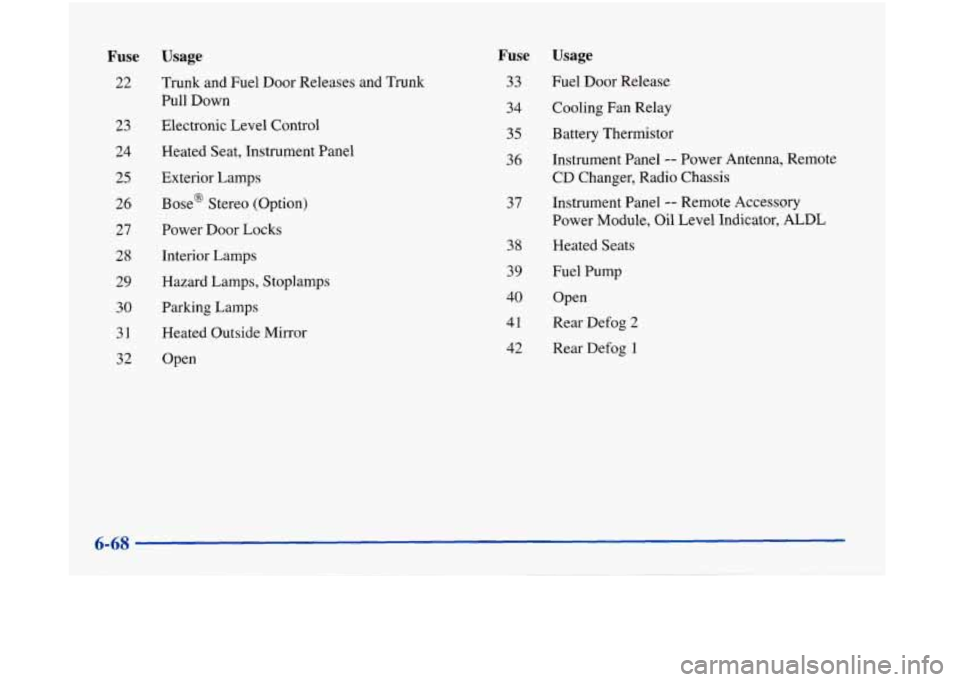
Fuse
22
23 24
25
26
27
28
29
30
31
32
Usage
Trunk and Fuel Door Releases and Trunk Pull Down
Electronic Level Control
Heated Seat, Instrument Panel Exterior Lamps
Base@ Stereo (Option)
Power Door Locks
Interior Lam]
Hazard Lamps, xoplamps
Parking Lamps
Heated Outside
Mirror
Open
Fuse Usage
33 Fuel Door Release
34 Cooling Fan Relay
35 Battery Thermistor
36 Instrument Panel
-- Power Antenna, Remote
CD Changer, Radio Chassis
Instrument Panel -- Remote Accessory
Power Module, Oil Level Indicator,
ALDL
37
38
39
40
41
42
Heated Seats
Fuel Pump
Open
Rear Defog
2
Rear Defog 1
Page 321 of 380

Engine Compartment Fuse Block
ENGINE COMPARTMENT FUSE
BLOCK
I HORN I1 I I FOG LAMP 2 I I II II I
COOLING
FAN #2
COOLING
FAN #3
Fuse
1
2
3
4
5
6
7
8
9
10
11
12
13
14
Usage
Air Conditioning Center
Open
Open
Horn Open
Fog Lamp 2
Cooling Fan #2
Cooling Fan #3
Cooling Fan
ABS Main
ABS Pump Motor
Fog Lamp
Horn
Open
6-69
.~.
Page 322 of 380
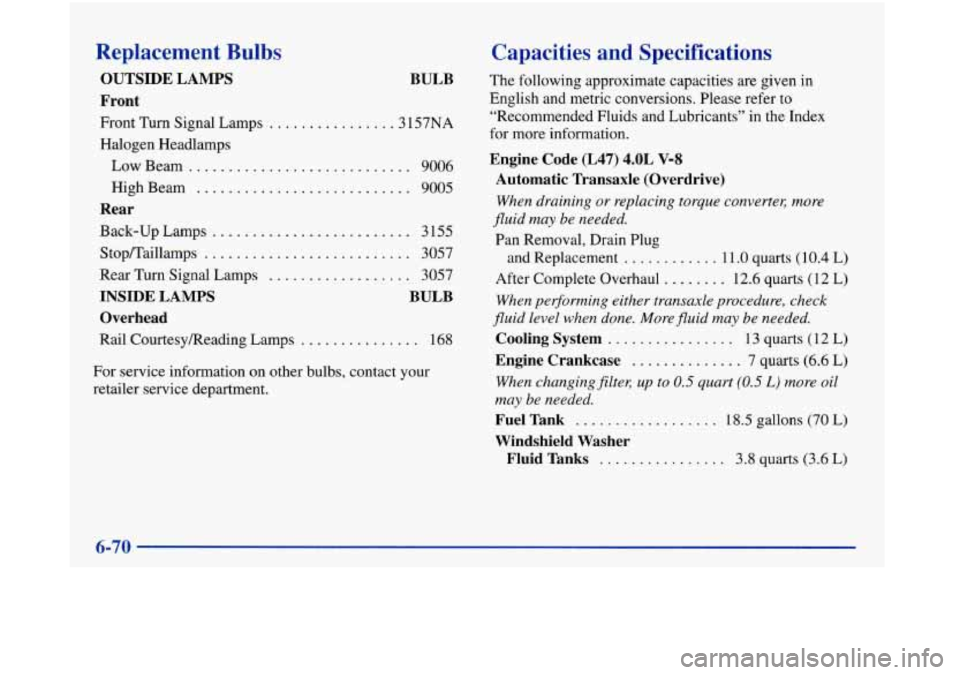
Replacement Bulbs
BULB
OUTSIDE LAMPS
Front
Front
Turn Signal Lamps ............... .3 157NA
Halogen Headlamps
Low Beam
............................ 9006
High Beam
........................... 9005
Rear
Back-up Lamps ......................... 3 155
StopKaillamps
.......................... 3057
Rear
Turn Signal Lamps .................. 3057
INSIDE LAMPS BULB
Overhead
Rail CourtesyReading Lamps ............... 168
For service information on other
bulbs, contact your
retailer service department.
Capacities and Specifications
The following approximate capacities are given in
English and metric conversions. Please refer to
“Recommended Fluids and Lubricants” in the Index
for more information.
Engine Code (L47) 4.0L V-8
Automatic Transaxle (Overdrive)
When draining or replacing torque converteq more
fluid may be needed.
Pan Removal, Drain Plug
and Replacement
............ 11 .O quarts (10.4 L)
After Complete Overhaul
........ 12.6 quarts (12 L)
When per$orming either transaxle procedure, check
fluid level when done. More fluid may be needed.
Cooling System ................ 13 quarts (12 L)
Engine Crankcase .............. 7 quarts (6.6 L)
When changingfllteq up to 0.5 quart (0.5 L) more oil
may be needed.
Fuel Tank .................. 18.5 gallons (70 L)
Windshield Washer
Fluid Tanks
................ 3.8 quarts (3.6 L)
6-70
Page 339 of 380
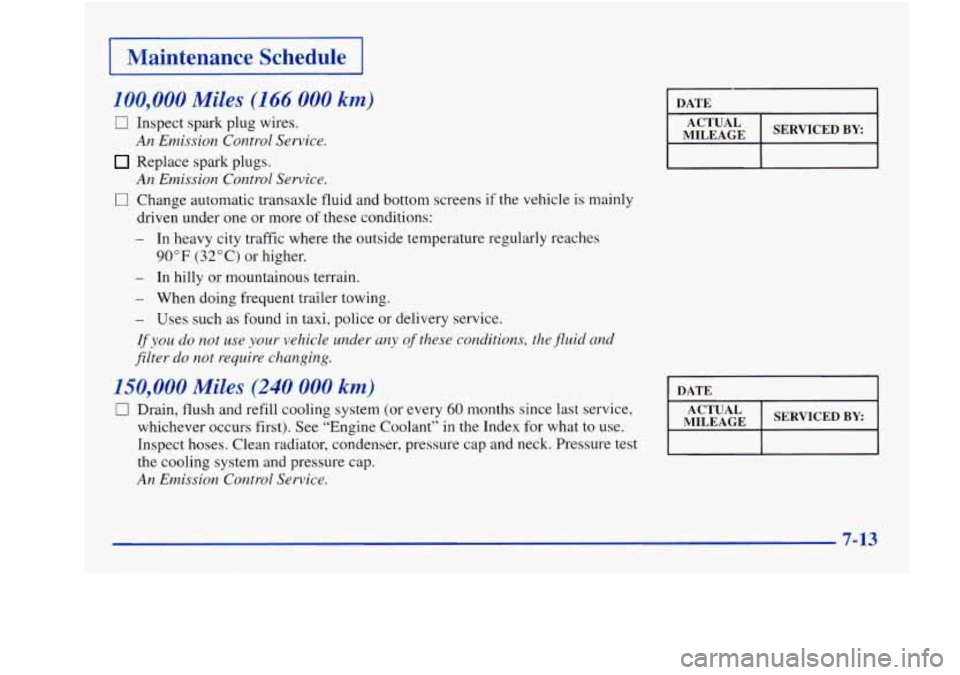
I Maintenance Schedule I
100,000 Miles (166 000 km)
0 Inspect spark plug wires.
Replace spark plugs.
0 Change automatic transaxle fluid and bottom screens if the vehicle is mainly
An Emission Control Service.
An Emission Control Service.
driven under one or more of these conditions:
I DATE 1
I MILEAGE ACTUAL I SERVICEDBY I
- In heavy city traffic where the outside temperature regularly reaches
90°F (32°C) or higher.
- In hilly or mountainous terrain.
- When doing frequent trailer towing.
- Uses such as found in taxi, police or delivery service.
If you do not use your veh.icle under any of these conditions, th.e jluid and
filter do not require changing.
150,000 Miles (240 000 km)
17 Drain, flush and refill cooling system (or every 60 months since last service,
MILEAGE whichever occurs first). See “Engine Coolant” in the Index for what to use.
Inspect hoses. Clean radiator, condenser, pressure cap and neck. Pressure test
the cooling system and pressure cap.
An Emission Control Service.
7-13
Page 344 of 380
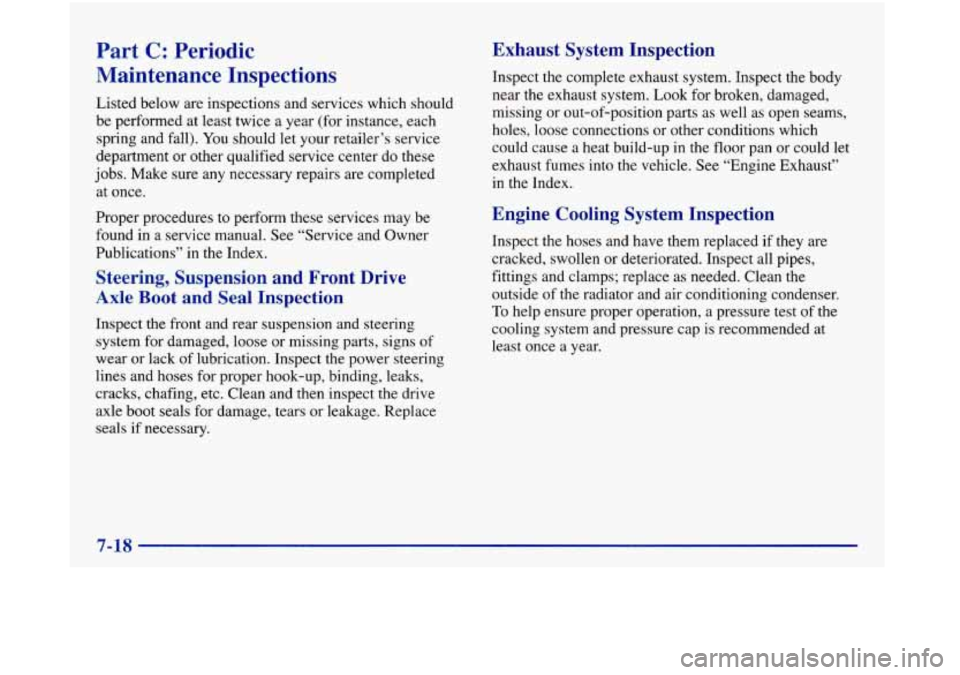
Part C: Periodic
Maintenance Inspections
Listed below are inspections and services which should
be performed at least twice a year (for instance, each
spring and fall). You should let your retailer’s service
department or other qualified service center do these
jobs. Make sure any necessary repairs are completed
at once.
Proper procedures to perform these services may be
found
in a service manual. See “Service and Owner
Publications” in the Index.
Steering, Suspension and Front Drive
Axle Boot and Seal Inspection
Inspect the front and rear suspension and steering
system for damaged, loose or missing parts, signs of
wear or lack of lubrication. Inspect the power steering
lines and hoses for proper hook-up, binding, leaks,
cracks, chafing, etc. Clean and then inspect the drive
axle boot seals for damage, tears or leakage. Replace
seals if necessary.
Exhaust System Inspection
Inspect the complete exhaust system. Inspect the body
near the exhaust system. Look for broken, damaged,
missing or out-of-position parts as well as open seams,
holes, loose connections or other conditions which
could cause a heat build-up in the floor pan or could let
exhaust fumes into the vehicle. See “Engine Exhaust”
in the Index.
Engine Cooling System Inspection
Inspect the hoses and have them replaced if they are
cracked, swollen or deteriorated. Inspect all pipes,
fittings and clamps; replace as needed. Clean the
outside of the radiator and air conditioning condenser.
To help ensure proper operation, a pressure test of the
cooling system and pressure cap is recommended at
least once a year.
7-18